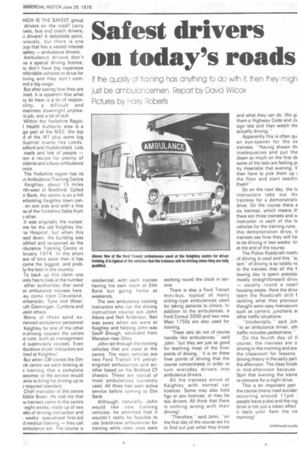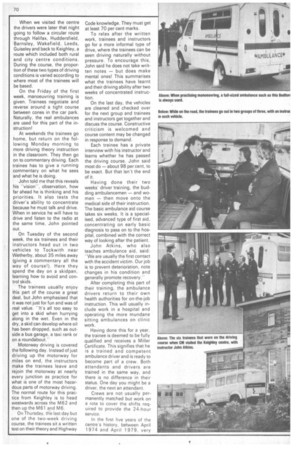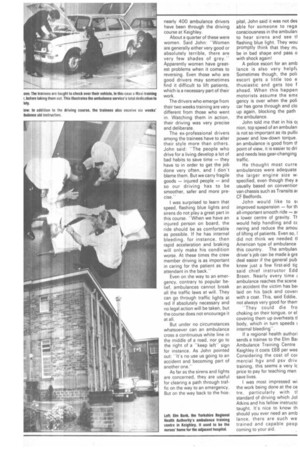Safest drivers on today's roads
Page 71

Page 72

Page 73

If you've noticed an error in this article please click here to report it so we can fix it.
If the quality of training has anything to do with it, then they migh just be ambulancemen. Report by David Wilcox Pictures by Harry Roberts
HIGH IS THE SAFEST group drivers on the road? Lorry Ivers, bus and coach drivers, (i drivers? A debatable point, iviously, but there is one pup that has a vested interest safety — ambulance drivers. Ambulance drivers don't ve a special driving licence, ly don't have big expensive mfortable vehicles to drive for living and they don't cornind a big wage.
But after seeing how they are ined, it is apparent that what Dy do have is a lot of respon
)ility, a difficult and metimes downright unpleant job, and a lot of skill.
Within the Yorkshire Regio1 Health Authority area is a ge part of the M62, the top d of the M1 plus some big Justrial towns like Leeds, adford and Huddersfield. Lots roads and lots of people — ten a recipe tor plenty of cidents and a busy ambulance rvice.
The Yorkshire region has its in Ambulance Training Centre Keighley, about 15 miles rth-west of Bradford. Called n Bank, the centre is on a hill erlooking Keighley town cen, on one side and with a fine tw of the Yorkshire Dales from other.
It was originally the nurses' me for the old Keighley Vicla Hospital, but when this ised down, the building was )(titled and re-opened as the nbulance Training Centre in bruary 1974. In the short ace of time since then it has come the biggest, and probly the best in the country.
To back up this claim one rely has to look at the number other authorities that send air ambulance trainees here. ley come from Cleveland, imberside, Tyne and Wear, uth Glamorgan, Cumbria and dere! others.
Many of these send exrienced ambulance personnel Keighley for one of the other Tedriving courses the centre ;o runs, such as management d supervisory courses. Even tbulance driver instructors are ined at Keighley?
But when CM visited the Elm nk centre we were looking at a training that a complete wcomer to the service would .teive to bring his driving up to 3 required standard.
Chief instructor at the centre Eddie Breen. He told me that w 'trainees come to the centre • eight weeks, made up of two teks of driving instruction and : weeks' specialised first-aid d medical training — they call ambulance aid. The course is residential, with each trainee having his own room at Elm Bank but going home at weekends.
The two ambulance training instructors who run the driving instruction course are John Atkins and Neil Anderson. Neil was away when we were at Keighley and helping John was Geoff Brough, seconded from Menston near Otley.
John ran through the training vehicles that are used at the centre. The main vehicles are two Ford Transit V4 petrolengined ambulances and another based on the Bedford CF chassis. These are typical of most ambulances currently used. All three had seen active service before coming to Elm Bank, Although, naturally, John would like new training vehicles, he admitted that it wouldn't really be feasible to use brand-new ambulances for training while older ones were working round the clock in service.
There is also a Ford Transit mini-bus, typical of many sitting-type ambulances used for taking patients to clinics. In addition to the ambulances, a Ford Consul 2000 and two new Maxi 1750s are also used for training.
"These cars do not of course handle like ambulances," said John "but they are just as good, for teaching most of the finer points of driving." It is on these finer points of driving that the course concentrates in order to turn everyday drivers into ambulance drivers.
All the trainees arrive at Keighley with normal car licences. Some may also hold hgv or psv licences, or may be taxi drivers. All think that there is nothing wrong with their driving!
"Therefore," said John, "on the first day of the course we try to find out just what they know and what they can do. We gi them a Highway Code and ro, sign test and then watch the actually driving."
Apparently this is often qu an eye-opener for the ne trainees. "Having shown thi inadequacies and put the down so much on the first clz some of the lads are feeling pi tty miserable that evening. V then have to pick them up the floor and start teachil them!"
So on the next day, the tv instructors take out the trainees for a demonstratii drive. On the course there a six trainees, which means ttthere are three trainees and a instructor in each of the Iv vehicles for the training runs. this demonstration drive, tl trainees see how they will ha to be driving in two weeks' tir at the end of the course.
The Police Roadcraft methi of driving is used and this "s) tern" of driving is so totally ne to the trainees that all the fi lowing day is spent practisii mostly straightforward drivii — usually round a nearl housing estate. Here the drive learn the Roadcraft drill f tackling what they previous thought were easy manoeuvre such as corners, junctions al other traffic situations.
"Incidentally," said Joh "to an ambulance driver, oth traffic includes pedestrians."
On the fourth day of tl course, the trainees are o driving in the morning and are the classroom for lessons driving theory in the early part the afternoon. The class finish in mid-afternoon because 9pm that evening the trains re-convene for a night drive.
This is an important part the course (many road accider occurring around 11 pm , people leave pubs) and the fig drive is not just a token effort it lasts until 4am the ne morning! When we visited the centre the drivers were later that night going to follow a circular route through Halifax, Huddersfield, Barnsley, Wakefield, Leeds, Guiseley and back to Keighley, a route which included both rural and city centre conditions.
During the course, the proportion of these two types of driving conditions is varied according to where most of the trainees will be based.
On the Friday of the first week, manoeuvring training is given. Trainees negotiate and reverse around a tight course between cones in the car park. Naturally, the real ambulances are used for this part of the instruction!
At weekends the trainees go home, but return on the following Monday morning to more driving theory instruction in the classroom. They then go on to commentary driving. Each trainee has to give a running commentary on what he sees and what he is doing.
John told me that this reveals his "vision", observation, how far ahead he is thinking and his priorities. It also tests the driver's ability to concentrate because he must talk and drive. When in service he will have to drive and listen to the radio at the same -time, John pointed out.
On Tuesday of the second week, the six trainees and their instructors head out in two vehicles to Tockwith near Wetherby, about 35 mites away (giving a commentary all the way of course!). Here they spend the day on a skidpan, learning how to avoid and control skids.
The trainees usually enjoy this part of the course a great deal, but John emphasised that it was not just for fun and was of real value, "It's all too easy to get into a skid when hurrying along in the wet. Even in the dry, a skid can develop where oil has been dropped, such as outside a bus garage, a taxi rank or on a roundabout."
Motorway driving is covered the following day, instead of just driving up the motorway for miles on end, the instructors make the trainees leave and rejoin the motorway at nearly every junction as practice for what is one of the most hazardous parts of motorway driving. The normal route for this practice from Keighley is to head westwards across the M62 and then up the M61 and M6.
On Thursday, the last day but one of the two-week driving course, the trainees sit a written test on their theory and Highway Code knowledge. They must get at least 70 per cent marks.
To relax after the written work, trainees and instructors go for a more informal type of drive, where the trainees can be seen driving naturally without pressure. To encourage this, John said he does not take written notes — but does make mental ones! This summarises what the trainees have learnt and their driving ability after two weeks of concentrated instruction.
On the last day, the vehicles are cleaned and checked over for the next group and trainees and instructors get together and discuss the course. Constructive criticism is welcomed and course content may be changed in response to demand.
Each trainee has a private interview with his instructor and learns whether he has passed the driving course. John said most do — about 98 per cent, to be exact. But that isn't the end of it.
Having done their two weeks' driver training, the budding ambulancemen — and women — then move onto the medical side of their instruction. The basic ambulance aid course takes six weeks. it is a specialised, advanced type of first aid, concentrating on early basic diagnosis to pass on to the hospital, combined with the correct way of looking after the patient.
John Atkins, who also teaches ambulance aid, said: "We are usually the first contact with the accident victim. Our job is to prevent deterioration, note changes in his condition and generally promote recovery."
After completing this part of their training, the ambulance drivers return to their own health authorities for on-the-job instruction. This will usually include work in a hospital and operating the more mundane sitting ambulances on clinic work.
Having done this for a year, the trainee is deemed to be fully qualified and receives a Miller Certificate. This signifies that he is a trained and competent ambulance driver and is ready to become part of a crew. Both attendants and drivers are trained in the same way, and there is no difference in their status. One day you might be a driver, the next an attendant.
Crews are not usually permanently matched but work on a rota to cover the shifts required to provide the 24-hour service In the first five years of the centre's history, between April 1974 and April 1979, very nearly 400 ambulance drivers have been through the driving course at Keighley.
About a quarter of these were women. Said John: "Women are generally either very good or absolutely terrible, there are very few shades of grey."
Apparently women have great est problems when it comes to reversing. Even those who are good drivers may sometimes find it difficult to lift patients, which is a necessary part of their work.
The drivers who emerge from their two weeks training are very different from those who went in. Watching them. in action, their driving was very precise and deliberate.
The ex-professional drivers among the trainees have to alter their style more than others John said: "The people who drive for a living develop a lot of bad habits to save time — they have to in order to get the job done very often, and I don't blame them. But we carry fragile goods — injured people — and so our driving has to be smoother, safer and more precise."
I was surprised to learn that speed, flashing blue lights and sirens do not play a great part in this course. When we have an injured person on board, the ride should be as comfortable as possible. If he has internal bleeding, for instance, then rapid acceleration and braking will only make his condition worse. At these times the crew member driving is as important in caring for the patient as the attendant in the back."
Even on the way to an emergency, contrary to popular belief, ambulances cannot break all the traffic laws at will. They can go through traffic lights at red if absolutely necessary and no legal action will be taken, but the course does not encourage it at all.
But under no circumstances whatsoever can an ambulance cross a continuous white line in the middle of a road, nor go to the right of a "keep left" sign for instance, As John pointed out "It's no use us going to an accident and becoming part of another one," As far as the sirens and lights are concerned, they are useful for clearing a path through traffic on the way to an emergency. But on the way back to the hos pital, John said it was not des able for someone to rega consciousness in the ambulan to hear sirens and see ti flashing blue light. They wou promptly think that they mi. be in bad shape and pass o with shock again!
A police escort for an amb lance is also very helpfi. Sometimes though, the poli escort gets a little too e thusiastic and gets too f ahead. When this happen motorists assume the em€ gency is over when the poll car has gone through and clo up again, blocking the path the ambulance.
John told me that in his 01 nion, top speed of an ambulan is not so important as its millii power and low-down torque. an ambulance is good from tF point of view, it is easier to dri and needs less gear-changing traffic.
He thought most curre ambulances were adequate the larger engine size w, specified, even though they a usually based on conventior van chassis such as Transits al CF Bedfords.
John would like to si improved suspension — for th all-important smooth ride — ar a lower centre of gravity. TF would help handling and cc nering and reduce the amou of lifting of patients. Even so, I did not think we needed tl American type of ambulance this country. The ambulan driver's job can be made a gre deal easier if the general pub knew just a few first-aid tic said chief instructor Edd Breen. Nearly every time r ambulance reaches the scene an accident the victim has be' laid on his back and cover( with a coat. This, said Eddie, not always very good for therr "They could die fro choking on their tongue, or el covering them up overheats tl body, which in turn speeds 1 internal bleeding".
If a regional health authori sends a trainee to the Elm Bal Ambulance Training Centre Keighley it costs £68 per wee Considering the cost of cor mercial hgv and psv driv training, this seems a very lc price to pay for teaching men save lives.
I was most impressed wi the work being done at the ce tre, particularly with tl standard of driving which Jol Atkins and his fellow instructc taught. It's nice to know th should you ever need an amb lance, there are such we trained and capable peop coming to your aid.
































































































































